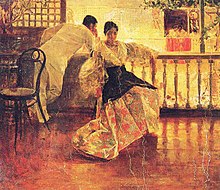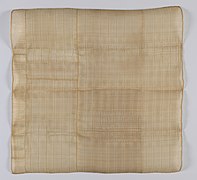A | B | C | D | E | F | G | H | CH | I | J | K | L | M | N | O | P | Q | R | S | T | U | V | W | X | Y | Z | 0 | 1 | 2 | 3 | 4 | 5 | 6 | 7 | 8 | 9
 Close-up view of the embroidery on a barong tagalog made with piña fiber | |
| Type | Fiber |
|---|---|
| Material | Pineapple leaf |
| Production process | Craft production |
| Place of origin | Philippines |
| Introduced | 17th century |
| Aklan piña handloom weaving | |
|---|---|
| Country | Philippines |
| Domains | Traditional craftsmanship |
| Reference | 01564 |
| Region | Asia and the Pacific |
| Inscription history | |
| Inscription | 2023 (18th session) |
| List | Representative |
Piña (Tagalog pronunciation: [pɪˈnja] pi-NYAH) is a traditional Philippine fiber made from the leaves of the pineapple plant. Pineapples are indigenous to South America but have been widely cultivated in the Philippines since the 17th century, and used for weaving lustrous lace-like luxury textiles known as nipis fabric. The name is derived from Spanish piña, meaning "pineapple".
History
Pineapples were introduced by the Spanish to the Philippines during the Spanish colonial era. The cultivar now known as 'Red Spanish' began to be cultivated for the textile industry as early as the 17th century. The extraction and weaving techniques were direct adaptations of the native weaving traditions using abacá fiber, which has a similar texture. Piña were woven into lustrous lace-like nipis fabrics usually decorated with intricate floral embroidery known as calado and sombrado.[1][2]


Piña fabric was a luxury export from the Philippines during the Spanish colonial period and gained favor among European aristocracy in the 18th and 19th centuries. Nipis fabrics were esteemed as exotic and sumptuous. Notable uses by royalty include the baptismal gown of King Alfonso XIII presented as a gift by Pope Pius X (now in the Museo del Traje); a piña handkerchief given as a wedding gift to Princess Alexandra of Denmark on her marriage to King Edward VII; as well as a petticoat and undergarment for Queen Victoria. An unfinished Maria Clara gown was also commissioned by the Marquis of Yriarte (then Governor of Laguna) intended for Queen Isabella II, who abdicated in 1870.[3] Numerous examples of 19th century embroidered piña textiles are in the collections of various museums around the world, although their history remains understudied in academic literature.[4]
Domestically, they were used to make the traditional barong tagalog, baro't saya, and traje de mestiza clothing of the Filipino upper class, as well as women's pañuelos. They were favored for their light and breezy quality, which was ideal in the hot tropical climate of the islands. The industry was destroyed in the Second World War and is only starting to be revived.[1][2][5]
Numerous pineapple-based dishes were also developed in the Philippines as a result of the pineapple textile industry. These include traditional ingredients and dishes like pineapple vinegar, hamonado, afritada, and pininyahang manok. Another notable by-product is a traditional jelly-like dessert called nata de piña, which has been produced in the Philippines since the 18th century.[6]
Production methods
Since piña is from a leaf, the leaf has to be cut first from the plant. Then the fiber is pulled or split away from the leaf. Most leaf fibers are long and somewhat stiff. Each strand of the piña fiber is hand scraped and is knotted one by one to form a continuous filament to be handwoven and then made into a piña cloth.
-
Scraping a pineapple leaf to reveal the fibers.
-
Preparing fibres for weaving
-
Traditional pina weaving
-
Traditional pina weaving
Producers
Kalibo, Aklan, is the main and the oldest manufacturer/weaver of piña cloth in the Philippines which are being exported to various parts of the world most particularly North America and Europe.[7] Piña weaving is an age-old tradition which was recently revived in the past 20 years.
Pineapple silk was considered the queen of Philippine fabrics and is considered the fabric of choice of the Philippine elite. During the 1996 APEC summit held in the Philippines, world leaders donned barong tagalog made of piña sourced from Kalibo during the group photo.
Producers include La Herminia Piña Weaving Industry,[8] Malabon Pina Producers and Weavers Association, Reycon's Piña Cloth and Industry, and Rurungan sa Tubod Foundation.[9]
Uses
Piña fabric is characterized by being lightweight but stiff, with a sheer appearance and a smooth silk-like texture. In modern times, it is predominantly used in the making of barong tagalog, baro't saya, and other traditional formal wear in the Philippines. It is also used for table linens, bags, mats and other clothing items.
UNESCO Recognition
Piña handloom weaving was nominated to UNESCO's Intangible Cultural Heritage List in 2023.[9] The decision was made at the 18th Intergovernmental Committee for the Safeguarding of the Intangible Cultural Heritage meeting held in Kasane, Botswana on 5–8 December 2023.[10]
External links
- Piña handloom weaving, UNESCO
Gallery
-
19th century cotton and piña textile in the Cooper Hewitt, Smithsonian Design Museum
-
19th century handkerchief made from piña with cotton embroidery
-
19th century barong tagalog made from piña and cotton
-
Early 19th century striped barong tagalog made from piña
-
Early 19th century camisa (women's blouse) made from piña and cotton
-
19th century pañuelo with silk and silver thread embroidery
-
Mid-19th century piña barong tagalog with patterns
See also
References
- ^ a b "History & Origin of Piña". Philippine Folklife Museum Foundation. Retrieved 13 December 2018.
- ^ a b "The History of Pineapple in the Philippines". Filipino Yum!. Retrieved 13 December 2018.
- ^ Coo, Stéphanie Marie R. (2014). Clothing and the colonial culture of appearances in nineteenth century Spanish Philippines (1820–1896) (PhD). Université Nice Sophia Antipolis.
- ^ Ramos, Marlene Flores (2016). The Filipina Bordadoras and the Emergence of Fine European-style Embroidery Tradition in Colonial Philippines, 19th to early-20th Centuries (PDF) (MA). Mount Saint Vincent University. S2CID 194439772. Archived from the original (PDF) on 12 February 2020.
- ^ Ewbank, Anne (6 September 2018). "This Prized Filipino Fabric Is Made From Pineapple Leaves". Gastro Obscura. Retrieved 13 December 2018.
- ^ Vergara, Benito S.; Idowu, Panna Melizah H.; Sumangil, Julia H. (1999). Nata de Coco: A Filipino Delicacy (PDF). National Academy of Sciences and Technology, Philippines. ISBN 9718538615.
- ^ Nestor Burgos (28 May 2010). "Aklan's piña looms start weaving again". Inquirer.net. Asian Journal. Archived from the original on 9 June 2012. Retrieved 3 December 2011.
- ^ "La Herminia – Piña Weaving Industry". Archived from the original on 30 October 2016. Retrieved 3 October 2017.
- ^ a b "UNESCO - Aklan piña handloom weaving". ich.unesco.org. Retrieved 6 January 2024.
- ^ "UNESCO - Eighteenth session of the Intergovernmental Committee for the Safeguarding of the Intangible Cultural Heritage". ich.unesco.org. Retrieved 6 January 2024.
>Text je dostupný pod licencí Creative Commons Uveďte autora – Zachovejte licenci, případně za dalších podmínek. Podrobnosti naleznete na stránce Podmínky užití.
File:Barong Up Close.jpg
Barong tagalog
Pineapple
Craft production
UNESCO Intangible Cultural Heritage Lists
Philippines
Template:UNESCO Representative List of the Intangible Cultural Heritage of Humanity/APA
Masterpieces of the Oral and Intangible Heritage of Humanity
Help:IPA/Tagalog
Help:Pronunciation respelling key
Philippines
Pineapple
History of the Philippines, 1565–1898
Cultivar
Piña Española Roja
Abacá
File:Tampuhan by Juan Luna.jpg
Juan Luna
Traje de mestiza
File:Kerchief MET 25.132.8.jpg
Pañuelo
Metropolitan Museum of Art
Linen
Baptismal gown
King Alfonso XIII
Pope Pius X
Museo del Traje
Alexandra of Denmark
King Edward VII
Petticoat
Undergarment
Queen Victoria
Maria Clara gown
Laguna (province)
Queen Isabella II
Abdication
Barong tagalog
Baro't saya
Traje de mestiza
Pañuelo
Second World War
Hamonado
Afritada
Pininyahang manok
Nata de piña
File:Pineapple-fiber-extraction.jpg
File:Piña-Seda- Pineapple and Silk Cloths from the Philippines 10.jpg
File:Piña-Seda- Pineapple and Silk Cloths from the Philippines 13.jpg
File:Piña-Seda- Pineapple and Silk Cloths from the Philippines 12.jpg
Kalibo
Aklan
APEC
Barong tagalog
Kalibo
Barong tagalog
Baro't saya
Philippines
UNESCO Intangible Cultural Heritage Lists
File:Kerchief (Pañuelo) MET 115249a.jpg
Pañuelo
Metropolitan Museum of Art
Linen
File:Textile (Philippines), 19th century (CH 18348723).jpg
Cooper Hewitt, Smithsonian Design Museum
File:Handkerchief (Philippines), 19th century (CH 18386747).jpg
File:Man's Shirt (Philippines), 1890–1900 (CH 18571417).jpg
Barong tagalog
File:Shirt MET 83.50.1 CP4.jpg
Barong tagalog
File:Blouse MET 37.109.1.jpg
File:Panel (Philippines), early 19th century (CH 18386599).jpg
Metallic fiber
File:Shirt MET 83.50.1 detail CP4.jpg
Abacá
Batik
Inabel
Malong
Nata de piña
Piñatex
Tapis (Philippine clothing)
T'nalak
S2CID (identifier)
ISBN (identifier)
Special:BookSources/9718538615
Template:Fibers
Template talk:Fibers
Special:EditPage/Template:Fibers
Fiber
Natural fiber
Fiber crop
Abacá
Bagasse
Bamboo textile
Musa basjoo
Coir
Cotton
Fique
Flax
Linen
Hemp
Jute
Ceiba pentandra
Kenaf
Lotus silk
Vegetable flannel
Raffia palm
Ramie
Rattan
Sisal
Wood fibre
Animal fiber
Alpaca fiber
Angora wool
Byssus
Camel hair
Cashmere wool
Catgut
Chiengora
Guanaco#Guanaco fiber
Hair
Llama#Fiber
Mohair
Pashmina (material)
Qiviut
Rabbit hair
Silk
Tendon
Spider silk
Wool
Vicuña#Vicuña wool
Yak fiber
Mineral fiber
Asbestos
Fiber#Chemical
Regenerated fiber
Artificial silk
Milk fiber
Semi-synthetic fiber
Cellulose acetate
Cellulose diacetate
Lyocell
Modal (textile)
Rayon
Cellulose triacetate
Mineral fiber
Glass fiber
Carbon fibers
Basalt fiber
Metallic fiber
Fiber#Polymer fibers
Acrylic fiber
Aramid
Twaron
Kevlar
Technora
Nomex
Microfiber
Modacrylic
Nylon
Olefin fiber
Polyester
Polyethylene
Ultra-high-molecular-weight polyethylene
Spandex
Vectran
Vinylon
Vinyon
Zylon
Category:Fibers
Category:Fibers
Piña
Piña
Main Page
Wikipedia:Contents
Portal:Current events
Special:Random
Wikipedia:About
Wikipedia:Contact us
Special:FundraiserRedirector?utm source=donate&utm medium=sidebar&utm campaign=C13 en.wikipedia.org&uselang=en
Help:Contents
Help:Introduction
Wikipedia:Community portal
Special:RecentChanges
Wikipedia:File upload wizard
Main Page
Special:Search
Help:Introduction
Special:MyContributions
Special:MyTalk
بينا
Piña-Handweberei
Piña (tela filipina)
Piña
പിനാ
पिना
ピニャ
Ananasfibrer
Special:EntityPage/Q3429320#sitelinks-wikipedia
Piña
Talk:Piña
Piña
Piña
Special:WhatLinksHere/Piña
Special:RecentChangesLinked/Piña
Wikipedia:File Upload Wizard
Special:SpecialPages
Special:EntityPage/Q3429320
Category:Piña (fiber)
Piña
Piña
Main Page
Wikipedia:Contents
Portal:Current events
Special:Random
Wikipedia:About
Wikipedia:Contact us
Special:FundraiserRedirector?utm source=donate&utm medium=sidebar&utm campaign=C13 en.wikipedia.org&uselang=en
Help:Contents
Help:Introduction
Wikipedia:Community portal
Special:RecentChanges
Wikipedia:File upload wizard
Main Page
Special:Search
Help:Introduction
Special:MyContributions
Special:MyTalk
بينا
Piña-Handweberei
Piña (tela filipina)
Piña
പിനാ
पिना
ピニャ
Ananasfibrer
Special:EntityPage/Q3429320#sitelinks-wikipedia
Piña
Talk:Piña
Piña
Piña
Special:WhatLinksHere/Piña
Special:RecentChangesLinked/Piña
Wikipedia:File Upload Wizard
Special:SpecialPages
Special:EntityPage/Q3429320
Category:Piña (fiber)
Piña
Piña
Main Page
Wikipedia:Contents
Portal:Current events
Special:Random
Wikipedia:About
Wikipedia:Contact us
Special:FundraiserRedirector?utm source=donate&utm medium=sidebar&utm campaign=C13 en.wikipedia.org&uselang=en
Help:Contents
Help:Introduction
Wikipedia:Community portal
Special:RecentChanges
Wikipedia:File upload wizard
Main Page
Special:Search
Help:Introduction
Special:MyContributions
Special:MyTalk
بينا
Piña-Handweberei
Piña (tela filipina)
Piña
പിനാ
पिना
ピニャ
Ananasfibrer
Special:EntityPage/Q3429320#sitelinks-wikipedia
Piña
Talk:Piña
Piña
Piña
Special:WhatLinksHere/Piña
Special:RecentChangesLinked/Piña
Wikipedia:File Upload Wizard
Special:SpecialPages
Special:EntityPage/Q3429320
Category:Piña (fiber)
Updating...x
Text je dostupný za podmienok Creative
Commons Attribution/Share-Alike License 3.0 Unported; prípadne za ďalších
podmienok.
Podrobnejšie informácie nájdete na stránke Podmienky
použitia.













